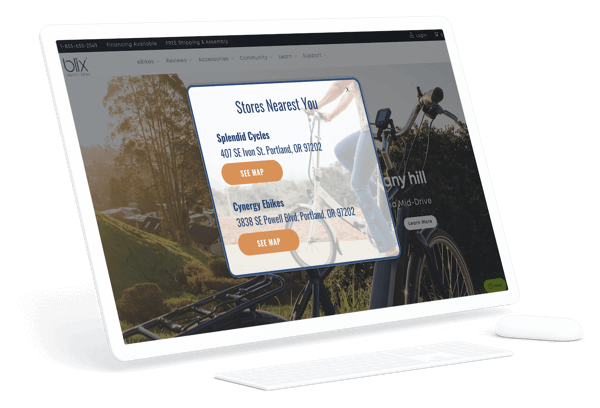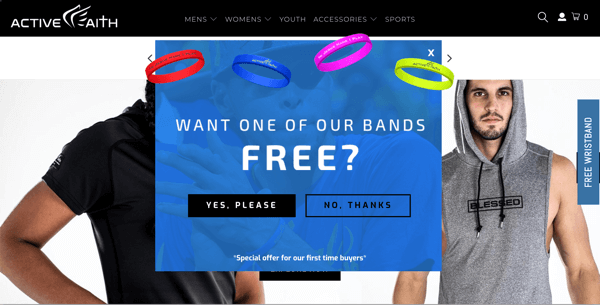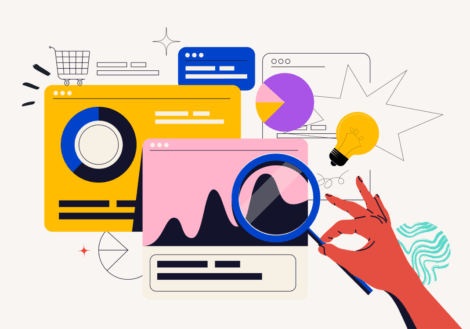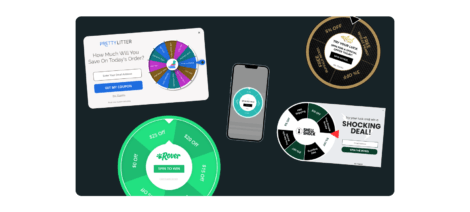The fast-paced world of conversion rate optimization (CRO) is constantly evolving which requires digital marketers to stay up to date on the latest technologies and terminology. This is a job in itself and most marketers just don’t have the time to stay up to date while also completing the tasks of the everyday grind.
Since marketing is an industry full of jargon, we’ve simplified things by compiling an ongoing list of conversion optimization terms that every digital marketer needs to know. This is a must-read for everyday marketers, business owners, and anyone interested in the world of conversion optimization and digital marketing.
Abandoned carts
Abandoned carts are the virtual equivalent of leaving your basket in the grocery store aisle. They occur when a website visitor adds items to their cart but leaves your website without completing their purchase. On average, 68% of shopping carts are abandoned. While this is a huge problem for online retailers, it can be used as a big opportunity to generate more sales revenue with targeted messaging to bring them back.
Above the fold
The top portion of a web page or email that is fully visible without having to scroll. Above the Fold content is what website visitors will see when they view a page or email. This content should be relevant and grab your visitors’ attention since it’s what they’ll see when they land on a page or open their email. Keep this top of mind when designing your website, landing pages, and emails. Think of it as the portion of newspapers you see – the main headlines and image, etc. It should contain the most important and attention grabbing information.
A/B testing
Testing one variation of a page or specific element on the page versus another variation of the same thing. Each variation is measured based on its performance against the other variation with regard to the test’s performance goal. You can perform an A/B test on almost every aspect of your marketing to continually improve your performance from ads, pop-ups, email, site design, and much more. See multi-variate testing for a related term.
Average order value (AOV)
Average order value is the average amount spent every time an order is placed on your website. To find this you’ll divide your total revenue by the number of orders. AOV is a commonly used metric to gauge performance and understand customers’ purchasing habits. Increasing AOV can be done with a variety of strategies like upselling, cross-selling, free shipping thresholds, or volume discounts.
AOV= Total Revenue / Number of Orders
Behavioral targeting
Behavioral targeting is a technique used to show certain messages (ads, pop-ups, etc.) to consumers based on actions they’ve taken in the past. This type of targeting increases the relevancy of your marketing messages for improved conversions and personalized experiences. Behavioral targeting includes data such as pages visited, clicked elements, search history, purchase history, traffic source, etc.
Bounce rate
Bounce rate is another key website performance metric. A bounce rate is the percent of site traffic that arrive on your website and then exit without visiting another page. High bounce rates can negatively affect SEO and speaks to the effectiveness of a page. Lower bounce rates can be achieved with more interesting on-page content, exit offers to catch attention, and other ways to encourage longer sessions times.
Buyer personas
Buyer personas are customer profiles, made up of qualitative and quantitative insights such as demographics and psychographics. They help make product development, marketing segmentation, etc. more effective by building out the bigger picture behind who is shopping your website. By looking at your marketing through a customer’s point of view you’ll create more effective sales funnels and boost conversions.
Call-to-Action (CTA)
A button or link that directs the visitor to take a specific action. Examples include the “add to cart” button on a product page, the “sign up” button for a registration form, and “download now” for an e-book. A CTA is the most critical aspect of your marketing since everything that counts as a conversion is done through them. . Check out seven examples of effective call-to-actions from Justuno users to help drive more conversions.
Click-Through Rate (CTR)
Click-through rates are the number of times something is clicked (ad, email link, pop-up, etc.) divided by the number of impressions (ad was seen, email was opened, etc.). The is an important metric for engagement and measuring interest. The equation for CTR is:
CTR= Total Clicks / Total Impressions
Conversion marketing
The act of marketing with the intention of increasing conversions. It’s important to understand the difference between conversion marketing and conversion optimization. The practice of ‘conversion rate optimization’ fits within the broad and often misunderstood umbrella that is ‘Conversion Marketing.’
Cookie
A piece of data that is stored to track a specific visitor’s browsing history and behavior on a website. Cookies allow businesses to provide more relevant and personalized experiences for their visitors. Companies like Apple, Firefox, and Google are constantly updating their privacy terms and how cookies (and tracking) function–make sure you’re operating within their best practices for optimal results.
Cost-per-click (CPC)
CPC is the actual cost of each click received on a paid ad, this is a crucial measurement of success and ROI for PPC campaigns.
CPC= (Competitor Ad Rank/Your Quality Score) + 0.01
Credibility
How believable and trustworthy your marketing, website, and product/service are. Ways to display credibility include testimonials, reviews, ratings, certifications, and security badges on your website.
Customer lifetime value (CLV)
CLV is the overall profit any customer brings your business over their lifetime as a customer. By knowing what each customer is worth you can better allocate your marketing resources and answer questions like “how much can I spend on customer acquisition and retention?” or “How much does it cost to acquire vs retain customers? Its equation is:
CLV = Average Purchase Value X Number of Orders Each Year X Average Number of Years As Customer
Decision fatigue
A psychological response when given too many choices. Providing individuals with more options to choose from creates anxiety and can result in overwhelming them, driving them to make no decision at all. Straight forward call-to-actions and differentiation are the best ways to combat this phenomenon.
Dynamic content
The different aspects of a website, ad, email, or pop-up that change based on data and past behavior of the individual. This allows businesses to present customized content specific to each individual. Examples of this include banners displaying shipping thresholds, abandoned cart emails featuring specific products, etc.

Exit offers
A type of pop-up presented to website visitors who attempt to leave a specific webpage. These pop-ups typically have messaging and an enticing offer aimed at keeping visitors on the site to complete the desired action. While often used interchangeably with abandoned carts, exit offers aren’t defined by a visitor’s cart contents, only their intent to leave.
Form
The location where your website visitors submit their information. This can be in exchange for an offer, to sign up for an account, or to subscribe to your newsletter. To ensure maximum usage, only ask for information that you need to effectively market to these leads. In most cases, only asking for an email will drive the most conversions.
Friction
Elements of your website that are distracting, confusing, or stressful for visitors. This can cause visitors to leave your website. Examples: too much text, too many form fields, unclear calls to action, or busy design.
Geo-targeting
A method of targeting individuals with messaging and promotions based on their current geographical location. Geo-targeting can be based on country, region, and even postal codes. This allows businesses, small and large, create a personalized website experience based on location and can be particularly powerful for merchants with a brick-and-mortar presence.

Heat maps
Heat maps are graphs representing website visitor behavior with color as a visual representation. They can help you narrow in on how visitors interact with and what they do on your site, uncovering pain points, key conversion points, etc. Options include: clicks, scroll, time spent, etc. Heat maps are powerful because of their visualization of data that can otherwise be overwhelming–they’re a key tool to CRO and overall website improvement.
Incentive
Something of value that drives a visitor to convert. A visitor is usually presented with relevant value in order to drive a purchase or submission of information. Examples of incentives are discounts, free shipping, e-books, white papers, free trials, free items, and so on.
Interruption
A tactic that purposely interrupts a person’s website visit in order to gain their full attention. We often see this tactic implemented using a pop-up or overlay. This brings the visitor’s full focus to your offer or message and displays the call to action clearly.
Key performance indicator (KPI)
Key performance indicators (KPI) are the most critical indicators of an intended or desired result. They should be focused on progress towards an end goal, serving as a quantifiable measurement of success towards it. KPI’s include a target, measurement, and reporting frequency. These are best used to steer your company’s strategic focus and decision making for future efforts, some examples are: Increase AOV by 5% by end of year, acquire 1,000 new visitors this quarter, etc.
Landing page
A page on your site that serves a clear and specific purpose. Landing pages are often used as the destination for paid ad traffic to land on so they have a simple, clear action to take once on site.
Latent conversion
A conversion that takes place after an individual’s initial visit. This occurs when a visitor views your website, leaves your site, and comes back at a different time to make a purchase. Look to acquire a visitor’s email during their first visit so you can re-target them later on and drive them back to your site. The longer your company’s sales cycle, the more prevalent latent conversions will be as opposed to same-session conversions.
Lead
A person who has indicated interest in your company’s product or service. This can be through submitting information, attending a webinar, or creating an account.
Lead generation
The ongoing process of attracting visitors to your site and converting them into prospects. The main goal of lead generation is to acquire a prospect’s email address so you can directly nurture them over time.
Long tail keyword
A targeted search phrase. It usually contains one “head” term, or generic search term, and multiple terms that refine the search phrase. Long tail keywords play a big role in capturing organic traffic and should be a part of your overall SEO strategy.
Head Term: E-Commerce Tools
Long Tail Keyword: E-commerce Tools for Conversion Optimization
Marketing funnel
A model representing the multiple stages of a prospect’s journey to actually converting, also commonly referred to as the customer journey. It traditionally consists of several steps including: Awareness, Interest, Conversion, Loyalty. There are many models of this with more granular stages but these are the major points in the funnel. Each stage reflects a difference in behavior, information sought, marketing materials, etc. Someone in the top of the funnel is only just becoming aware of a need they have vs. someone at the bottom directly comparing two products–market accordingly!
Micro-conversion
Small actions that you ask visitors to perform leading up to a bigger conversion step. By using this technique, you can increase engagement while also influencing people to take the intended action. An example of this is using intro screens on your pop-ups, something featuring an obvious question (“Do you like free stuff?”) makes them more likely to say yes again when it comes to asking for their email. Micro-commitments open the door to engagement and follow through; and make a great example of a strategy to A/B test on your website.

Personalization
Targeting an audience with content that appears to have been created specifically for an individual. Personalization is key in email marketing and on-site marketing. Common examples of personalization are greeting a person by their first name, showing products based on search and purchase history, and displaying content that is specific to a person’s location or industry.
Pop-ups
Pop-ups, overlays, onsite messages–the list is endless for this one. Pop-ups are a window that opens within a page to engage a visitor with relevant info, promotions, or offers. They’re a key component of any conversion optimization strategy by augmenting the website experience and engaging traffic more than a static website experience and collecting customer data.
PPC (Pay-Per-Click)
A type of digital advertising in which ads are displayed in search results or in designated ad space and you are only required to pay for each click of the advertisement. This is mainly used for search engine marketing and is the answer when your website needs help beyond that of organic ranking and traffic. While commonly used interchangeably with cost per click (CPC) it’s not the same as this is a style of ads while CPC is the money spent on that click.
Product recommendation
A dynamic personalization strategy where a visitor is recommended other products based on their previous behavior. Can be on-site, in emails, pop-ups, etc. and strategies for recommendations can vary widely. Suggest complementary or substitute products, most purchased, etc. These not only help personalize a shopper’s experience with relevant suggestions but also provide an opportunity to increase AOV and conversion rates with more visibility. Justuno Plus users have exclusive access to AI-powered product recommendations for even more powerful results.
Relevance
How relevant your products, services, offers, or content are to a visitor’s wants and needs. You need to demonstrate relevance early on in a visit because attention spans are short and distractions are bountiful.
Remarketing
A collection of tactics that are used to follow up with leads in an attempt to get them to convert. Remarketing involves automated email campaigns, targeted emails, and specific offers based on previous actions taken.
Segmentation
Dividing your customers and prospects into subsets based on behavior and data. Segmentation enables you to provide targeted content that is relevant to each subset. This also allows you to identify which segments are performing the best and where to focus your marketing efforts.
Scarcity
Marketing uses rarity and exclusivity to drive desired actions. “Limited Time Offer” and “Only 3 Left” are common ways to portray scarcity and drive people to take action.
Social proof
Also called the “Bandwagon effect,” it’s the human tendency to do something because others are doing it. This is often seen in e-commerce in the form of good reviews, showing low stock, or recently purchased messaging. Essentially it’s the marketing tactics of “see others are buying it so you should too.”
Value exchange
Presenting something of value and relevance on your website in order to receive information from your visitors. This process occurs by incentivizing people with an offer that they can only receive by submitting some information, i.e. get 20% off by subscribing to our newsletter.
User Generated Content (UGC)
UGC is content made by your customers or users on their own. It can be in many forms like social posts, reviews, testimonials, photos, etc and is a commonly used form of social proof. Shoppers inherently trust UGC more than something a brand says or creates about itself which is why it’s a great CRO tactic to display it on your product pages so visitors can see happy customers for themselves.
Urgency
Closely related to scarcity. Usually, urgency is time-focused and involves driving an individual to take action based on creating a sense of urgency. Use countdown times in emails and pop-ups for maximum urgency and FOMO on a deal. Urgency is a huge part of driving same-session conversions and speeding up the sales cycle.



